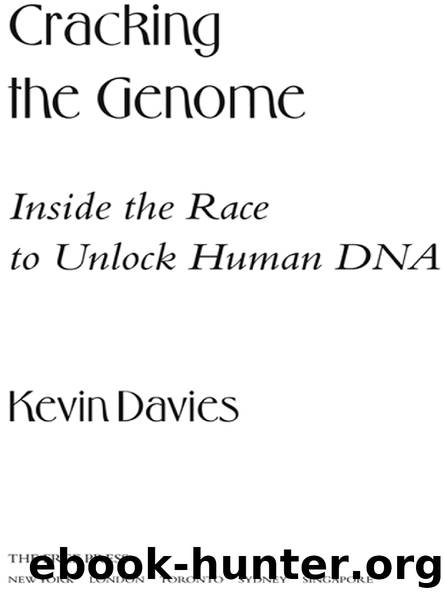Cracking the Genome by Kevin Davies

Author:Kevin Davies
Language: eng
Format: epub
Publisher: THE FREE PRESS
Published: 2001-07-15T00:00:00+00:00
Last but not least, the Whitehead Institute’s Eric Lander bagged his personal favorite chromosome—17, which had been his lucky number since he became fascinated by its unique mathematical properties—and helpfully “whatever needs to be done.” With an extraordinary résumé, Lander had earned the right to select his own projects. His early interest was in mathematics; he won the Westinghouse Science Talent competition at age seventeen (for a paper on quasiperfect numbers), a Rhodes scholarship to Oxford, followed by a MacArthur “genius” award. In the early 1980s, while teaching mathematics at Harvard Business School, Lander began moonlighting at MIT, learning molecular biology from, among others, his younger brother Arthur, a neuroscientist. In 1989, Lander joined the faculty of the Whitehead Institute, affiliated with MIT, and was later appointed director of the Whitehead Institute Genome Center. Lander sensed that his mathematical expertise could be a powerful tool in the booming field of human genetics, which was searching for ways to map disease genes. He has applied those skills to help determine appropriate criteria for forensic DNA fingerprinting and mapping of genes for complex traits, while constructing a comprehensive genetic map of the mouse.
In the past few years, the Whitehead Institute Genome Center has become the flagship of the U.S. genome effort, with Lander supervising an army of more than two hundred researchers and technicians and producing about a third of the human sequence. Despite his entrepreneurial flair (in 1993, he cofounded Millennium Pharmaceuticals), Lander’s loyalty in the genome race lay firmly behind the public genome project—or as he jokingly refers to it, “the Forces of Good.”
VENTER SET UP HIS NEW CORPORATE HEADQUARTERS in a 200,000-square-foot facility on the northern outskirts of Rockville, Maryland, just eighteen miles from the White House and a few subway stops away from Collins’s office at NIH. The office building formerly belonged to a government defense contractor and was sandwiched between the electric company and a housing development. It was hardly an exotic location, but Venter did not have the luxury of time. In August 1998, his team was moving in.
As each $300,000 sequencing machine was installed and checked, Celera scientists began naming each machine after a famous science-fiction character, affixing the new monikers with masking tape. There were Leia and Skywalker from Star Wars, Ripley and Hicks from Alien, and many others. The machines were stacked neatly in rows, patiently awaiting the first samples. On another floor, generic laboratories were constructed, where Smith and colleagues would caringly prepare the human DNA for sequencing. The monthly electricity bill to run the sequencers, computers, and air conditioning was $100,000.
By early 1999, the data center was operational. Compaq had built one of the two largest civilian computers in the world, rivaled only by an Intel-built machine used by the U.S. government for classified modeling of nuclear explosions. The computer contained some 800 Alpha EV6 and EV67 processors with 64-bit architecture and over 80 terabytes of memory (equivalent to five times the Library of Congress) housed in a specially designed quarters about the size of a basketball court.
Download
This site does not store any files on its server. We only index and link to content provided by other sites. Please contact the content providers to delete copyright contents if any and email us, we'll remove relevant links or contents immediately.
Sapiens: A Brief History of Humankind by Yuval Noah Harari(14327)
The Tidewater Tales by John Barth(12629)
Mastermind: How to Think Like Sherlock Holmes by Maria Konnikova(7281)
Do No Harm Stories of Life, Death and Brain Surgery by Henry Marsh(6910)
The Thirst by Nesbo Jo(6882)
Why We Sleep: Unlocking the Power of Sleep and Dreams by Matthew Walker(6661)
Life 3.0: Being Human in the Age of Artificial Intelligence by Tegmark Max(5520)
Sapiens by Yuval Noah Harari(5328)
The Longevity Diet by Valter Longo(5044)
The Body: A Guide for Occupants by Bill Bryson(5035)
The Rules Do Not Apply by Ariel Levy(4913)
The Immortal Life of Henrietta Lacks by Rebecca Skloot(4552)
Animal Frequency by Melissa Alvarez(4431)
Why We Sleep by Matthew Walker(4398)
The Hacking of the American Mind by Robert H. Lustig(4342)
Yoga Anatomy by Kaminoff Leslie(4336)
All Creatures Great and Small by James Herriot(4277)
Double Down (Diary of a Wimpy Kid Book 11) by Jeff Kinney(4245)
Embedded Programming with Modern C++ Cookbook by Igor Viarheichyk(4145)
